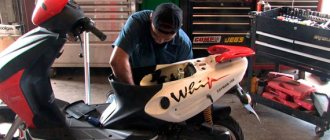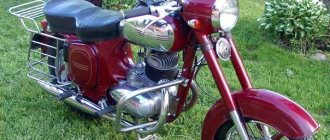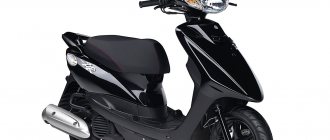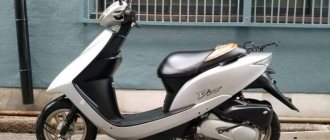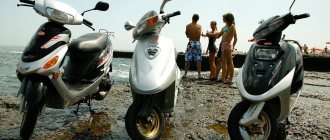In 2003, the production of the Honda Dio AF 62 scooter began, which will be discussed in this review. The scooter is quite popular in Russia, although it is inferior to its predecessors due to a different type of engine. In 2007, the line underwent a slight “rebranding”; This is how the Honda Dio AF68 model was released. It is slightly different from the previous Dio in terms of frame, engine and some technical characteristics, although it remains the same as before - universal. Let's take a closer look at the AF 62/68 series and compare the two scooters.
Appearance
Honda Dio AF 62 has a classic “Honda” fairing with metal fasteners, pointed in the shape of a triangle at the front, crystal optics and a lightweight steel frame.
The photo shows the Honda BA-AF62 scooter model.
Interesting! Until the 2000s, almost all models in the Dio line were produced with a steel frame; the AF 62 was one of the “pioneers”, as it was equipped with an aluminum structure.
At the front there is an 80/100 R10 wheel, from which there is a diagonal slope to the steering column. The turn signals and lights are not separated by anything; the scooter is additionally equipped with two mirrors on long footrests.
Photos of the front and rear optics of the Honda Dio AF 62. Years of production of the scooter: 2003-2007.
In the rear part, on a small plastic stand, there is a trunk attached to the seat. Below it are pointed taillights, shaped deeper into the fairing, and an 80/100 R10 wheel is covered by the rear fender. The side of the disc is covered with a massive muffler.
Dio AF 62 has a comfortable and wide double seat. It is quite easy to seat a passenger with a driver, and there is also a trunk at the rear. The entire scooter is very roomy, as there is a luggage compartment under the driver’s seat that can easily accommodate a helmet. There is also a glove compartment in front of the driver where you can put small things, and in addition to this, you can install a basket on the scooter.
The dry weight of the scooter is 73 kg, full weight is 77 kg.
It is important that the AF 62 changed the location of the gasoline tank: now it is also located behind the seat, which has finally established its place in the design of 50 cc scooters from Honda.
Scooter parameters
Honda Dio AF 62/68 has the following parameters: length – 1720 mm, width – 630 mm, height – 1020 mm. The wheelbase is 1180 mm and the ground clearance is 110 mm. The total weight is 77 kg.
Pros:
The handles are more massive, an additional ignition on/off button has been installed, and a button has been added to the left side of the steering wheel that can be used to blink the high beams. Model Sym Symphony SR 125 Yamaha Grand Axis Nirvana 150CC Viper Storm 150 Suzuki Address V110 Stels Outlander 150 Stels Vortex Irbis Grace 150 Honda PCX-150 Nexus F22-S Engine capacity cm3 124.6 101 150 150 113 150 149 150 153 150 Power hp 9 10 10.1 9.6 11 11.4 9.7 10 14 8.2 Number of cylinders 1 1 1 1 1 1 1 1 1 1 Number of strokes 4 2 4 4 2 4 4 4 4 4 Max.
Technical characteristics of Honda Dio AF 62
Scooter model: Honda BA-AF62. The maximum speed, electronically limited, is 60 km/h. The volume of the gas tank is 5 liters, the oil tank is 0.68 liters. Front wheel: 80/100-10, rear wheel: 80/100-10.
Dimensions Honda Dio AF 62/68 (L x W x H): 1720 x 630 x 1020 mm.
Engine AF61E
The Honda Dio AF62 scooter is equipped with a single-cylinder four-stroke AF61E engine with forced air cooling. Power is 4.1 hp at 8000 rpm, maximum torque is 3.7 Nm at 6500 rpm. The piston stroke is 44 mm, the cylinder diameter is 37.8 mm. Compression when rotating the knee using an electric starter is 12 kg/cm².
Transmission
The transmission is a continuously variable variator with a V-belt (V-matic). The braking system, despite the year of manufacture, consists of two drum brakes both front and rear.
Honda Dio AF 62/68 front suspension – telescopic fork, rear – pendulum.
Note! Drum brakes are good for dusty roads, but they don't provide good stopping power on asphalt.
The suspension is represented by a straight telescopic fork (front) and a swingarm with a spring assembly (rear).
Fuel consumption Honda Dio AF 62
At an average speed of 30 km/h, gasoline consumption on the Honda Dio AF 62 is 1.53 liters. It may be larger or smaller depending on the current condition of the scooter itself, as well as the road surface and other conditions.
- Scooter model – Honda BA-AF62;
- Engine – AF61E, 4-stroke, 1-cylinder;
- Power unit volume – 49.9 cm³;
- Cylinder diameter – 37.8 mm;
- Piston stroke – 44.0 mm;
- Compression ratio – 10.1;
- Engine power, (hp / rpm) – 4.1 /8000;
- Torque, (H*m/rpm) – 3.7 /6500;
- Cooling – air;
- Fuel system – carburetor (VKODB);
- Average fuel consumption – 1.53 liters/100 km;
- Gas tank volume – 5.0 liters;
- Oil tank – 0.7 liters;
- Maximum speed – 60 km/h;
- Front brake type – drum;
- Rear brake type: drum;
- Tire size (front/rear) – 80/100-10 46J;
- Front suspension – telescopic fork;
- Rear suspension – pendulum;
- The scooter frame is aluminum;
- Transmission – CVT (V-Matic);
- Start type – kickstarter/electric starter;
- Scooter dimensions, (L x W x H) – 1720 x 630 x 1020 mm;
- Seat height – 695 mm;
- Wheelbase – 1180 mm;
- Ground clearance – 110 mm;
- Turning radius – 1.8 m;
- Scooter weight (dry/full) – 73/77 kg.
Tire size (front/rear) on Dio AF 62 and AF 68 – 80/100-10 46J. Front and rear brakes are drum type.
Posts 1 page 20 of 45
Share1Saturday, March 12, 2011 16:51
- Author: Basilisk
- Forum Administrator
- Posts: 249
- From: Khabarovsk
- Phone: 66-73-77
- Registered: Saturday, March 12, 2011
- Time spent on the forum: 6 days 18 hours
- Last visit: Saturday, April 14, 2022 23:02
- Respect: [+2/-0]
- Positive: [+8/-0]
- Age: 28 [1991-11-22]
- Gender: Male
Scooter Honda Dio device operation prevention repair CONTENTS
1. Abbreviations and symbols 2. General repair instructions 3. Identification 4. Description and recommendations 4.1 Maintenance recommendations 4.2 Some recommendations for operating the scooter 5. Maintenance and general inspection and adjustment procedures 5.1 Maintenance intervals 5.2 Location of control systems , power, electrical equipment 5.3 Body parts (SK50M) 5.4 Adjusting the headlight 5.5 Adjusting the oil pump 5.6 Checking the fuel pump 5.7 Cleaning the air filter 5.8 Checking the pressure at the end of the compression stroke 5.9 Checking the brake linings 6. Power unit 6.1 Oil pump 6.2 Oil tank 6.3 Throttle 6.4Carburetor 6.5 Reed valve 6.6 Fuel tank 6.7 Fuel pump 6.8 Air filter 6.9 Removing and installing the engine 6.10 Disassembling and assembling the engine 6.11 Cylinder head, cylinder and piston 6.12 Power unit housings 6.13 Kick starter 6.14 Variator 6.15 Final drive 6.16 Engine crankcase 7.Pro verification and repair of power unit 8. Chassis 8.1 Front suspension and front brake (SK50M) 8.2 Checking the front brake assembly 8.3 Braking system with front disc brake (SK50M) 8.4 Throttle handle 8.5 Rear suspension and rear brake 8.6 Shock absorber 9. Electrical equipment 9.1 Battery 9.2 Voltage regulator ( rectifier) 9.3 Generator 9.4 Breaker (CDI unit) 9.5 Ignition coil 9.6 Checking the ignition timing 9.7 Starter 9.8 Fuel level sensor 9.9 Oil level sensor 9.10 Ignition switch 9.11 Turn signal switch 9.12 Lamps 9.13 Steering switches 9.14 Electrical circuits equipment
Share2Tuesday, April 5, 2011 09:00
- Author: Cooltishka
- Honorary member of the club
- Posts: 962
- From: Khabarovsk, Berezovka village
- Scooter: Meiduo MD50QT-15? Riga 11, Suzuki
- ICQ: 368672754
- Phone: 604023
- Registered: Saturday, March 12, 2011
- Time spent on the forum: 23 days 5 hours
- Last visit: Wednesday, January 2, 2022 22:04
- Respect: [+5/-0]
- Positive: [+0/-1]
- Age: 35 [1984-06-09]
- Gender: Male
In general, yesterday I bought a new piston, installed locks on the exhaust, installed the rings correctly (they didn’t stick), there is gasoline from ROSNEFT, there is a spark, but it won’t start. Who knows why!?
Share3Tuesday, April 5, 2011 11:41
- Author: Cooltishka
- Honorary member of the club
- Posts: 962
- From: Khabarovsk, Berezovka village
- Scooter: Meiduo MD50QT-15? Riga 11, Suzuki
- ICQ: 368672754
- Phone: 604023
- Registered: Saturday, March 12, 2011
- Time spent on the forum: 23 days 5 hours
- Last visit: Wednesday, January 2, 2022 22:04
- Respect: [+5/-0]
- Positive: [+0/-1]
- Age: 35 [1984-06-09]
- Gender: Male
Defects and methods for eliminating them - Piston group (we do not take into account the destruction of the CVM elements)
1. Check compression: with a compression ratio of 7:1, normal compression is 9.5-10.5 kg/cm?. Below 8.0-8.5 kg/cm?, indicates increased wear of the piston group, scuffing and sticking are possible. This significantly increases fuel consumption. Remedy: Replacement (boring) of the cylinder-piston group.
2. With normal compression, increased wear of the piston skirt is often encountered; the external manifestation is a characteristic ringing metallic knock at the bottom of the cylinder (many classify this as a knock of the piston pin), especially noticeable during throttling. Remedy: if the cylinder is in normal condition, the defect can be eliminated by replacing the piston, new one is the same size. If there is noticeable wear on the cylinder, see point 1
3 a). The engine does not develop power, and over time it becomes increasingly weaker. A common cause is a clogged muffler. The check is simple - just check it for resistance to blowing (in other words, blow into the removed muffler) - there should not be significant resistance. Remedy: If resistance is felt, the muffler must be cleaned. There are two ways here: 1) burn it - heat it in a fire or with a blowtorch until it turns red until the acrid smoke stops coming out; 2) cut, remove all carbon deposits and weld back.
3c. The engine does not develop power, and over time it becomes increasingly weaker. Sometimes the exhaust window of the cylinder becomes clogged with carbon deposits (especially clearly visible from the inside - from the piston side). Remedy: The windows need to be cleaned.
4. Poor starting, unstable operation, the engine does not maintain idle speed, or does not start at all. The reason is the lack of tightness of the cavity of the crank mechanism (crankcase) or the cylinder may be due to: a) Violation of the integrity of the gasket under the cylinder head, between the cylinder and the crankcase. c) Violation of the tightness of the connection of the crankcase halves c) Deterioration or destruction of the crankshaft oil seals d) Lack of tightness of the valve box (Suzuki)
Advantages and disadvantages
Advantages:
- Rigid frame.
- Engine with a durable and reliable piston group.
- High quality plastic.
- Spacious and under-seat storage.
- Availability of passenger space.
- Attractive fairing shape.
- Easy replacement of battery and consumables.
Flaws:
- Maintenance cost.
- Low engine power and torque.
Options for choosing a scooter up to 150 cc. m.. Honda ninja rp 80
As the engine crankshaft rotates, air is forced into the hose until the pressure in the hose equals the maximum pressure in the cylinder. Naturally, from the above, it follows that leaks will be minimal if the cylinder has a perfectly round shape, there are no longitudinal marks on its working surface, the piston rings fit perfectly to it and to the end surfaces of the piston grooves; if the gaps in the ring locks are close to zero and, finally, the valve plates fit perfectly to the seats.
Comparison of Honda Dio AF 62 and AF 68
In 2007, the Honda Dio AF 62 model was revised. The model was given a new number AF68. The new product has similar characteristics to the AF62, but differs in the type of fuel supplied to the engine, as a result of which the engine received a different index - AF67E. It also remained air-cooled.
Unlike the AF62, the modified AF68 model has electronic fuel injection control - an injector, instead of a carburetor.
The frame was replaced, several new color options for the fairing body appeared, and the shape of the plastic itself changed a little.
On the left in the photo is Dio AF68, on the right is AF62.
Technical characteristics of Dio AF 68 in comparison with AF 62: engine brand - AF67E (AF61E - Dio 62). The electronically limited maximum speed is 60 km/h, the AF62 gas tank volume is 5 liters (4.6 liters for the AF68), the oil tank volume is 0.7 liters (0.65 for the AF68). The Dio AF 62/68 is equipped with front and rear tires measuring 80/100 R10. Also, the brakes are the same - drums front and rear. Suspension: telescopic fork at the front, pendulum with shock absorber at the rear. All scooters have differences, Dio62 – 77 kg, AF68 – 81 kg.
Healthy! Engines with electronically controlled fuel injection pick up speed evenly and are less prone to jerking.
Honda JBH-AF68 scooter model with a 4-stroke fuel-injected engine 4.1 l/s. Fuel consumption is 1.36 liters per 100 km (at 30 km/h).
There were no changes in the overall characteristics: length – 1720 mm, width – 630 mm, height – 1020 mm. The wheelbase is 1180 mm, ground clearance is 110 mm.
Thus, both models are suitable for traveling around the city and on dusty roads in the countryside.
Technical characteristics of Dio AF 68
- Model – Honda JBH-AF68;
- Engine – AF67E, 4-stroke, 1-cylinder;
- Power unit volume – 50 cm3;
- Cylinder diameter – 37.8 mm;
- Piston stroke – 44.0 mm;
- Compression ratio – 10.1;
- Engine power, (hp / rpm) – 4.1 /8250;
- Torque, (H*m/rpm) – 3.7 /7500;
- Cooling – air;
- Fuel system - injector (PGM-FI);
- Average fuel consumption – 1.36 liters/100 km;
- Gas tank volume – 4.6 liters;
- Oil tank – 0.6 liters;
- Maximum speed – 60 km/h;
- Front brake type – drum;
- Rear brake type: drum;
- Tire size (front/rear) – 80/100-10 46J;
- Front suspension – telescopic fork;
- Rear suspension – pendulum;
- The scooter frame is aluminum;
- Transmission – CVT (V-Matic);
- Start type – kickstarter/electric starter;
- Scooter dimensions, (L x W x H) – 1720 x 630 x 1020 mm;
- Seat height – 695 mm;
- Wheelbase – 1180 mm;
- Ground clearance – 110 mm;
- Turning radius – 1.8 m;
- The weight of the scooter is 81 kg.
If you measure compression
cm Tank capacity, l Consumption, l 100 km Speed, km h Country of manufacture Dimensions LxWxH, cm Weight, kg Price, rubles Honda Dio AF68 4 49 4.6 1.25 60 Japan 172x63x102 73 160000 Yamaha JOG RR 2 49.9 5 .5 1.65 69 Japan 174x67.5x106.5 84 90000 Suzuki Address V50 4 49.9 4.5 1.25 60 Japan 167x60.5x100.5 66 80000 Suzuki Lets5 4 49 5 1.5 60 Japan 169.5x60x99, 5 68 75000 OMAKS MATADOR 50CC 2 50 4.5 2.5 70 Italy 184.6 67.5 117.3 98 60000 SYM ORBIT50 4 49.58 5.2 2 65 Taiwan 190x69x112.5 100 60000 KEEWAY Street 50 2 49, 3 5.6 2 49 China 186x68x119.8 94 55000 Racer Meteor RC50QT-3 4 49.5 6 2.1 49 Russia 170x66x107 74 46500 LIFAN LF50QT-26 4 49 6 2 45 China 186x68x111 95 40000 Irbis LX 50 2 49.9 6 2.5 90 Russia 192x69x114.5 100 36000 Stels Skif 2 49.8 5.8 2 65 Russia 174x66x113 82 35000 STELS TACTIC 50 2 50 4.8 2.5 70 Russia 180x108.5x70.2 99 33000 .7 l Front telescopic suspension Travel 80 mm Rear suspension pendulum with mono-shock absorber Travel 60 mm Front hydraulic disc brake 190 mm Rear hydraulic disc brake 190 mm Front wheel 2.
Difference between Honda Dio AF62 and Dio Cesta
The year of manufacture of the Honda Dio Cesta AF 62 is 2004. The Honda Dio scooter in the Cesta modification differs from the AF 62 in the following ways:
On the left in the photo is a Dio Cesta 2004, on the right is a Dio AF62
- Larger dry weight 77 kg (full 81 kg).
- Less seat height 690 mm.
- The turn signals and optics are located at the bottom of the fairing (under the basket).
- Increased load capacity (200 kg).
- Thicker and more massive steering wheel.
- The scooter is equipped with a large basket in the front for 24 kg.
- The outer plastic and footrest are painted in different colors.
- Another dashboard.
Honda Dio Cesta AF62 (2004-2007) with 4-stroke engine (AF61E) 4.1 l/s. Fuel consumption 1.5 liters per 100 km (at 30 km/h).
Spare parts for internal tuning of Honda Dio AF62 Cesta are similar to Dio AF 62.
Criterias of choice
I bought it and tried it right away, it was my very first trip, then I felt its power. I quickly got used to it and on the third day I drove almost at full power. I went to refuel and came across a 14% rise on my way. I was surprised that he climbed it so easily. I turned the handle halfway and he just flew up that climb. At a maximum speed of 90 km/h, nothing happens to it, the dynamics are simply wonderful. I recommend for purchase.
Brakes
Brakes can be installed either drum type or disc. The disc brake mounted on the front wheel is a great thing. If you compare it with a hundred and ten, which has drum brakes, the difference is noticeable.
No cables! How the brake hose is installed on the car. There is a box with brake fluid on the steering wheel.
Price Honda Dio AF 62/68
The price of a Honda Dio AF 62/68 varies depending on where you buy the equipment from. There are two options: purchase a moped on the Russian used market or order it without mileage in Russia from Japan. In the first case, the equipment will cost 25-35 thousand rubles, depending on condition and mileage, in the second - 40-50-60 thousand rubles for a good scooter. You can buy a Honda Dio AF 62/68 through advertisements from dealers delivering equipment from Japanese auctions on the website Drom.ru
You can find a profitable Honda Dio AF 62/68 scooter in good condition on the website Drom.ru
Suzuki Address 110
Reliable brakes and excellent handling make the scooter the No. 1 choice for many.
The scooter can be found in almost any specialized store in Moscow, but you can buy it from us for only 55,000 rubles in silver:
Tired of moving around, constantly sweating and pedaling? No money for a car? Is there constant traffic jams in the city that make it so difficult to get to work? Do you want new driving sensations? If you answered yes to at least one question, then you should think about purchasing a scooter.
Summary
Honda Dio AF 62 is an excellent and inexpensive scooter with a four-stroke engine. It is slightly inferior in efficiency and smoothness to the injection version of the AF 68, but it costs a little less. The scooters are essentially universal, but thanks to the high ground clearance of 110 mm and two drum brakes, they can easily withstand a country trip under small rough terrain.
Reviews of the Honda Dio AF 62/68 confirm that this pair is one of the most economical and resourceful among the entire line. Since 2007, the scooter complies with Euro 4 standards.
Manuals for scooters
or scooters and how to deal with them.
Honda Common Service Manual
pdf General manual for the operation and maintenance of Honda engines for motorcycles, scooters and ATVs. 1988 and scan quality below average



